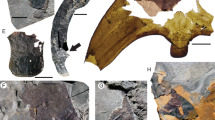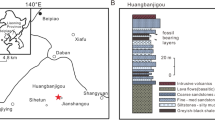Abstract
Although fossils of Orsten-type preservation represented by Skaracarida and Phosphatocopina were first reported from the Middle and Upper Cambrian in western Hunan, South China in 2005, diversified phosphatocopine species have never been appropriately described and elucidated in terms of their evolutionary relationships. Here, we described two new species of Phosphatocopina, Vestrogothia anterispinata sp. nov. and V. bispinata sp. nov. The evolutionary relationship among all the valid species of Phosphatocopina is discussed and the phylogeny of Phosphatocopina is reestablished using cladistic analysis. Accordingly, phosphatocopines primitively evolved along two lineages: one evolved towards the emergence of lobes; the other evolved towards the emergence of dorsal spines. Respectively, lobes originated independently three times, and dorsal spines originated only once. With regard to the dorsal rims, interdorsum originated first, whereas dorsal furrow originated independently twice on the basis of interdorsum. Probably Hesslandona may represent a polyphyletic group, whereas Vestrogothia a monophyletic group.
Similar content being viewed by others
References
Müller K J. Phosphatocopine ostracodes with preserved appendages from the Upper Cambrian of Sweden. Lethaia, 1979, 12(1): 1–27
Müller K J. Exceptional preservation in calcareous nodules. Philos Trans Royal Soc London B, 1985, 311: 67–73
Müller K J. Upper Cambrian “Orsten”. In: Briggs D E G, Crownther P R, eds. Palaeobiology-A Synthesis. Oxford: Blackwell Scientific Publications, 1990. 274–277
Müller K J, Walossek D. “Orsten” arthropods-Small in size but of great impact on biological and phylogenetic interpretations. In: Geologiska Föreningens i Stockholm Förhandlingar (GFF) Meeting Proceeding 113(1). Stockholm: Sveriges Geologiska Undersökning (SGU), 1991, 113: 88–90
Walossek D, Müller K J. The “Alum Shale Window”-Contribution of “Orsten” arthropods to the phylogeny of Crustacean. Acta Zool, 1992, 73(5): 305–312
Walossek D, Müller K J. Cambrian “Orsten”-type arthropods and the phylogeny of Crustacean. In: Fortey R A, Thomas R H, eds. Arthropod Relationships, Systematics Association Special Volume Series 55. London: Chapman and Hall, 1998. 139–153
Walossek D, Müller K J. Early arthropod phylogeny in the light of the Cambrian “Orsten” fossils. In: Edgecombe G D, ed. Arthropod Fossils and Phylogeny. New York: Columbia University Press, 1998. 185–231
Walossek D. The ‘Orsten’ Window-A three-dimensionally preserved Upper Cambrian Meiofauna and its contribution to our understanding of the evolution of Arthropoda. Paleont Res, 2003, 7: 71–88
Butterfield N J. Exceptional fossils preservation and the Cambrian explosion. Integr Comp Biol, 2003, 43: 166–177
Dong X P, Donoghue P C J, Liu Z, et al. The fossils of Orsten-type preservation from Middle and Upper Cambrian in Hunan, China-Three-dimensionally preserved soft-bodied fossils (Arthropods). Chin Sci Bull, 2005, 50(13): 1352–1357
Liu J, Dong X P. Skara hunanensis a new species of Skaracarida (Crustacea) from Upper Cambrian (Furongian) of Hunan, South China. Prog Nat Sci, 2007, 17(8): 934–942
Zhang X G, Siveter D J, Walossek D, et al. An epipodite-bearing crown-group crustacean from the Lower Cambrian. Nature, 2007, 449(7162): 595–598
Maas A, Braun A, Dong X P, et al. The ‘Orsten’-More than a Cambrian Konservat-Lagerstätte yielding exceptional preservation. Paleoworld, 2006, 15: 266–282
Müller K J, Walossek D, Zakharov A. ’Orsten’ type phosphatized soft-integument preservation and a new record from the Middle Cambrian Kuonamka Formation in Siberia. Neues Jahrbuch für Geologie und Palntologie (Abh.), 1995, 191(1): 101–118
Maas A, Walossek D, Müller K J. Morphology, Ontogeny and Phylogeny of the Phosphatocopina (Crustacean) from the Upper Cambrian ‘Orsten’ of Sweden. Fossils and Strata, No. 49, London: Taylor & Francis Group, 2003. 1–238
Huo S C, Shu D G. Cambrian Bradoriida of South China. Xi’an: Northwest University Press, 1985. 1–251
Zhang X G. Moult stages and dimorphism of Early Cambrian bradoriids from Xichuan, Henan, China. Alcheringa, 1987, 11: 1–19
Walossek D, Hinz-Schallreuter I, Shergold J H, et al. Three-dimensional preservation of arthropod integument from the Middle Cambrian of Australia. Lethaia, 1993, 26: 7–15
Siveter D J, Williams M, Walossek D. A phosphatocopid crustacean with appendages from the Lower Cambrian. Science, 2001, 293: 479–481
Dong X P, Donoghue P C J, Cheng H, et al. Fossil embryos from the Middle and Late Cambrian period of Hunan, south China. Nature, 2004, 427(6971): 237–240
Briggs D E G, Kear A J. Fossilization of soft tissue in the laboratory. Science, 1993, 259: 1439–1442
Briggs D E G, Kear A J, Martill D M, et al. Phosphatization of soft-tissue in experiments and fossils. J Geol Soc London, 1993, 150: 1035–1038
Martin D, Briggs D E G, Parkes R J. Decay and Mineralization of Invertebrate Eggs. Palaios, 2005, 20: 562–572
Raff E C, Villinski J T, Turner F R, et al. Experimental taphonomy shows the feasibility of fossil embryos. Proc Natl Acad Sci USA, 2006, 103: 5846–5851
Gostling N J, Thomas C W, Greenwood J M, et al. Deciphering the fossil record of early bilaterian embryonic development in light of experimental taphonomy. Evol Dev, 2008, 10: 339–349
Gostling N J, Dong X P, Donoghue P C J. Ontogeny and taphonomy: An experimental taphonomy study of the brine shrimp Artemia salina. Palaeontology, 2009, 52(1): 169–186
Maas A, Walossek D. Phosphatocopina-Ostracode-like sistergroup of Eucrustacea. Hydrobiologia, 2005, 538: 139–152
Hinz-Schallreuter I. Ein mittelkambrischer hesslandonider Ostrakod sowie zur Morphologie und systematischen Stellung der Archaeocopa. Archiv für Geschiebekunde, 1993, 1(6): 329–448
Hinz-Schallreuter I. Cambrian Ostracodes mainly from Baltoscandia and Morocco. Archiv für Geschiebekunde, 1993, 1(7): 385–448
Müller K J. Ostracoda (Bradorina) mit phosphatischen Gehäusen aus dem Oberkambrium von Schweden. Neues Jahrbuch der Geologie und Paläontologie, Abhandlungen, 1964, 121(1): 1–46
Hinz-Schallreuter I. Population structure, life strategies and systematics of phosphatocope ostracods from the Middle Cambrian of Bornholm. Mitteilungen aus dem Museum für Naturkunde Berlin, Geowissenschaftliche Reihe, 1998, 1: 103–134
Hinz-Schallreuter I. Baltoscandian Phosphatocopes. Archiv für Geschiebekunde, 2000, 2(12): 841–896
Walossek D. On the Cambrian diversity of Crustacea. In: Schram F R, von Vaupel Klein, J C, eds. Crustaceans and the Biodiversity Crisis. Proceedings of the Fourth International Crustacean Congress. Leiden: Brill Academic Publishers, 1999. 3–27
Walossek D. Cambrian ‘Orsten’-type arthropods and the phylogeny of crustacea. In: Legakis A, Sfenthourakis S, Polymeni R, et al, eds. The New Panorama of Animal Evolution. Sofia and Moscow: Pensoft Publishers, 2003. 69–87
Siveter D J, Waloszek D, Williams M. An Early Cambrian phosphatocopid crustacean with three-dimensionally preserved soft parts from Shropshire, England. In: Lane P D, Siveter D J, Fortey R A, eds. Trilobites and Their Relatives. Spec Papers Palaeont, 2003, 70: 9–30
Walossek D. The Upper Cambrian Rehbachiella and the phylogeny of Branchiopoda and Crustacea. Fossils and Strata, No. 32. Oslo-Stockholm: Scandinavian University Press, 1993. 1–201
Author information
Authors and Affiliations
Corresponding author
Additional information
Supported by National Natural Science Foundation of China (Grant Nos. 40772008, 40572003), Research Fund for Doctoral Program of High Education (Grant No. 20060001059), State Key Laboratory of Palaeobiology and Stratigraphy, Nanjing Institute of Geology and Palaeontology, Chinese Academy of Sciences (Grant No. 083101)
Rights and permissions
About this article
Cite this article
Zhang, H., Dong, X. Two new species of Vestrogothia (Phosphatocopina, Crustacea) of Orsten-type preservation from the Upper Cambrian in western Hunan, South China. Sci. China Ser. D-Earth Sci. 52, 784–796 (2009). https://doi.org/10.1007/s11430-009-0069-0
Received:
Accepted:
Published:
Issue Date:
DOI: https://doi.org/10.1007/s11430-009-0069-0




